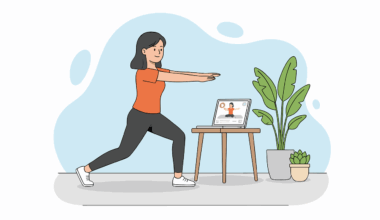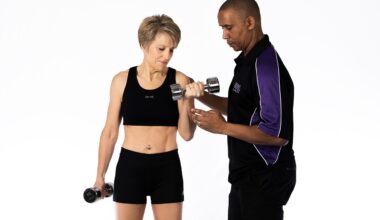Upper Body Gym Workout: Tips and Techniques
When it comes to upper body workouts, it is essential to understand the various muscle groups that need to be targeted. Strengthening these areas not only enhances physical appearance but also improves overall functionality. Focusing on muscles such as the pectorals, deltoids, biceps, and triceps is crucial for achieving a balanced physique. Incorporating exercises like push-ups, bench presses, and dumbbell flyes will lead to substantial gains. It is advisable to structure your workouts into various sets and reps to effectively challenge your muscles. Aim for different workout intensities to swing from lighter weights with more reps to heavier weights with fewer reps. This method ensures continuous growth and prevents plateaus. Additionally, warming up before engaging in strenuous activities will prepare your muscles efficiently for heavy lifting. Always remember to cool down and stretch post-workout to foster recovery. Hydration is critical during your upper body workouts, so keep water available. Finally, keep a journal of your workouts to track progress and adjust your routines accordingly to improve over time. Consistency is key in achieving your upper body fitness goals.
Incorporating various equipment into your workouts can significantly enhance your upper body routines. While free weights like dumbbells and barbells are popular choices, machines also offer their advantages. Machines provide stability and control during exercises, making them suitable for beginners who focus on form. Using resistance bands is another great tool, allowing for variable resistance and engaging your muscles dynamically. When creating a workout plan, assess the range of motion offered by each piece of equipment. This consideration will help ensure that your workout is both safe and effective. Additionally, including bodyweight exercises like pull-ups and dips can develop substantial upper body strength and endurance. A balanced workout routine might consist of different modalities targeting all muscle groups. It can prove beneficial to vary your workouts every few weeks to avoid monotony and stimulate muscle growth. Mixing compound movements, which engage multiple muscles, with isolation exercises, targeting specific muscles, will provide a well-rounded approach. For serious lifters, consider periodization, where you plan your workouts in phases, gradually increasing intensity over time. This strategy leads to long-term progress and helps sustain motivation throughout your fitness journey.
Form and Technique
Maintaining proper form and technique during upper body workouts is of utmost importance. Correct alignment prevents injuries and maximizes the effectiveness of each exercise. When performing exercises like bench presses or shoulder presses, ensure your back is flat against the bench to protect your spine. Your feet should remain firmly planted on the ground for stability. Breathe correctly by exhaling during exertion and inhaling on the release. This breathing technique supplies oxygen to your muscles, improving performance. Engaging your core throughout all movements ensures additional stability and balance, fostering optimal technique. Always start with lighter weights to master the movements before progressing to heavier loads. Accountability is essential in this process; consider hiring a personal trainer or working with a workout partner who can provide feedback and corrections. Filming your workouts can also enhance your self-assessment. Moreover, don’t push through pain; learn to listen to your body and modify exercises as needed. Failure to heed warning signs may lead to serious injuries, ultimately derailing your workout journey. Sticking to effective form will ensure that you achieve desired results safely and sustainably.
Nutrition also plays a critical role in your upper body workout success. Fueling your body with the right nutrients aids in recovery and enhances performance. Prioritize protein intake to support muscle repair and growth, as each muscle tear during workouts needs to be mended with adequate nutrition. Lean meats, fish, beans, and dairy are excellent protein sources to include in your diet. Carbohydrates provide necessary energy for your workouts, thus perfect for maintaining stamina as you lift weights. Consider complex carbohydrates like whole grains, fruits, and vegetables for a sustained energy release. Don’t neglect healthy fats; they are crucial for hormone production and overall well-being. Stay hydrated throughout your workout, as dehydration can significantly impair performance and recovery. Post-workout, aim for a balanced meal rich in protein and carbs to replenish your energy stores effectively. Some individuals find that nutritional supplements, such as protein powders or amino acids, can enhance muscle recovery after demanding workouts. However, these should not replace whole food sources but rather complement your diet. By understanding nutrition’s role in your fitness routine, you will boost recovery and maximize results from your upper body workouts.
Setting Goals
Establishing clear, measurable goals for your upper body workouts helps to sustain motivation and monitor progress effectively. Consider setting both short-term and long-term goals to keep yourself focused. Short-term goals may include increasing the number of push-ups or improving bench press weight within a month. In contrast, long-term goals could involve achieving a specific weight, body fat percentage, or muscle definition. Make sure that your goals are achievable and realistic based on your current fitness level. Using the SMART criteria—Specific, Measurable, Achievable, Relevant, and Time-bound—can help create a structured approach to your fitness goals. Tracking your progress through fitness apps or journals will help you stay accountable and allow for adjustments as needed. Share your progress with friends or on social media for additional motivation, but focus primarily on personal achievement. Celebrating milestones big and small will keep your spirits high and encourage consistency. A support network, whether family, friends, or a gym community, is often invaluable during this journey. Their support can bolster your commitment to reaching your upper body fitness goals.
Recovery is a pivotal component often overlooked in workout regimes. Your upper body workouts place considerable stress on numerous muscle groups; therefore, incorporating recovery strategies is essential for optimal results. Allow adequate rest between workout sessions to let muscles rebuild and strengthen. Many recommend taking at least 48 hours before targeting the same muscle groups again. Active recovery activities, such as light stretching or yoga, can aid in maintaining flexibility while promoting recovery. Schedule regular rest days to allow your entire body to recuperate, preventing excessive fatigue. Additionally, quality sleep is crucial for recovery, as growth hormones released during sleep directly support muscle repair. Consider incorporating foam rolling or massage techniques into your routine to alleviate muscle soreness. Hydration continues to be critical for recovery as well, helping to flush out toxins and reduce muscle fatigue. Supplements like Omega-3 fish oil may further speed up the recovery process and minimize inflammation. Paying attention to these recovery strategies is essential for preventing injuries, ensuring that you can continue to pursue your upper body workout goals effectively and sustainably.
Consistency and Adjustments
Commitment to your upper body workout routine will yield substantial benefits over time. Being consistent with your exercises will help solidify your progress and embed healthy habits into your lifestyle. However, it is also imperative to be attentive to your workout; making adjustments as necessary in response to your body’s feedback can lead to better outcomes. If you find certain exercises becoming too easy, gradually increase the weights or the number of repetitions. On the other hand, if an exercise feels overly challenging or painful, consider modifying it or consulting with a fitness expert. Regularly assess your workout plan to ensure that it remains engaging and aligned with your goals. Setting a schedule for your workouts increases the likelihood that you will stick to it. Consider tracking your workouts for added motivation. Using a fitness tracker or app can be an excellent way to review performance data and monitor progress effectively. Adapt to changes in your lifestyle and circumstances, and embrace adjustments rather than see them as deterrents. Ultimately, embracing a flexible but dedicated approach will make significant strides toward your upper body fitness objectives over time.
Lastly, celebrating your successes, both big and small, will enhance your workout experience tremendously. As you reach milestones in your upper body workouts, acknowledge the effort you’ve put forth and the progress you’ve made. This celebratory mindset fosters positive reinforcement and keeps motivation high. Consider rewarding yourself after accomplishing specific goals, such as buying new workout gear or treating yourself to a favorite meal. Joining fitness challenges or competitions can also provide external recognition and validation of your hard work. Engaging with communities and networks allows sharing of achievements, further bolstering your drive to improve. Social media platforms can also serve as an excellent venue for showcasing your progress and fostering connections with like-minded individuals. However, always remember that the journey itself is worth celebrating, regardless of the destination. Embrace the learning process and the challenges you face along the way, as they will contribute significantly to your growth. Documenting your experiences through journaling or blogging can be a therapeutic outlet and a record of your journey. Overall, fostering a balance between the challenges and the rewards will lead to sustained success and enjoyment of your upper body workouts.


